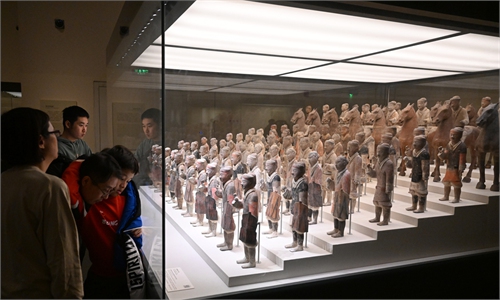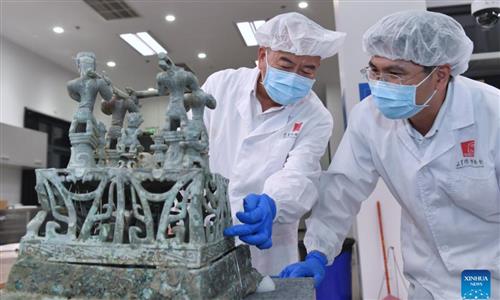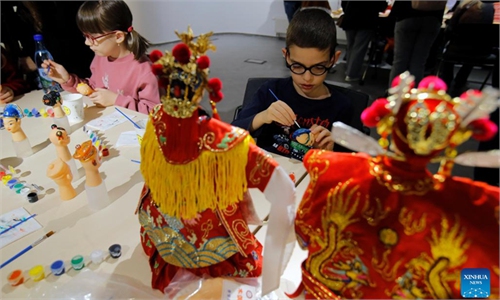ARTS / CULTURE & LEISURE
Integrating literature, art and cultural relics for creative transformation

Tian Qinxin
Editor's Note:
Outstanding literary and artistic works reflect a nation's creativity and cultural capabilities. Meanwhile, cultural relics carry splendid civilizations, transmit historical cultures, and sustain the spirit of nations - they are precious legacies left by our ancestors. This article by Tian Qinxin, president of the National Theater of China, explores the integration of literature, art and cultural relics to present China's treasures, pride and spirit to today's young people and the whole world as well.

A stage photo for the musical drama The Summoning of Dunhuang Photo: IC
Outstanding literary and artistic works reflect a nation's creativity and cultural capabilities. Meanwhile, cultural relics carry splendid civilizations, transmit historical cultures, and sustain the spirit of nations - they are precious legacies left by our ancestors. Historical and cultural heritage are passed down from our forebears; we must pass it on intact to future generations.
China, a land of abundant cultural heritage, is dotted with historical relics that bear the genes and bloodline of our Chinese nation. These treasures encapsulate the great creativity, wisdom, and collective memory of the Chinese people, serving as powerful testaments to the continuity, innovation, unity, inclusiveness, and peacefulness of Chinese civilization. They are profound nourishment for building a socialist spiritual civilization. Hence, preserving cultural relics benefits the present and future alike.
The integration of "literature, art plus cultural relics" signifies two treasures converging with shared delight. Literature and art empowering cultural preservation is a concrete practice under the "Two Integrations," or the integration of the basic tenets of Marxism with China's specific realities and traditional culture.
Revitalizing tradition can ignite artistic creativity, vitalizing the stories of cultural relics through artistic forms, awakening the national DNA within artifacts through transcendent expressions, and evoking reverence for our civilization.
Next, I will share my perspectives on the integration of "literature, art plus cultural relics" from three aspects.
First, infusing cultural relics into literature and art can bridge the past, present, and future.
While relics are deemed silent witnesses of history, each artifact speaks inwardly when unveiled. Though voiceless, it communicates. When the Shang Dynasty's (c.1600BC-1046BC) Hou Mu Wu Bronze Ding (food container) - China's heaviest known bronze ritual vessel - was unearthed in Anyang, Central China's Henan Province, in 1939, its colossal form, majestic grandeur, and exquisite craftsmanship revealed ancient aspirations for auspiciousness and abundance. Cast by King Wen Ding to honor his mother, the ding's motifs embody filial piety and blessings. Such a creation was a narrative; adapting it into art allows more people to feel the bond between the mother and son. In art, the Hou Mu Wu Bronze Ding transcends being a relic - it becomes a conduit linking the past to the present. This is the true significance of "Why Artifacts Matter!"
As excavators of cultural stories and creators of art, we must first immerse ourselves in historical knowledge, then transform antiquity's "past tense" into a "present continuous tense" through artistic expression.
Literature and art activate the contemporary vitality of cultural relics, clarifying our national identity. Infusing relics with artistic life rejuvenates the national spirit within them. Delving into cultural heritage and repurposing historical materials enables creative transformation and innovative development.
Exemplifying this synergy is the 2024 musical drama The Summoning of Dunhuang, co-produced by the National Theater of China and supported by the National Cultural Heritage Administration.
The narrative of The Summoning of Dunhuang centers on a century-spanning dialogue between an intern at the Dunhuang Digital Research Center in 2035 and the painter Chang Shuhong, who was called to Dunhuang in 1935.
The entire performance employs musical sequences to weave a narrative, driving the plot through acting and dance sequences. By integrating digitally generated visual creations, static Dunhuang murals spring to life, enabling audiences to traverse the aesthetic evolution of Dunhuang across dynasties while showcasing the resplendent allure of its art.
This production pioneered AI-driven stagecraft in theatrical performances, integrating 3D visual effects, real-time filming, and 2D animation. Multi-screen installations within the stadium enabled rapid shifts across multi-dimensional historical timelines from 1935 to 2035, combining cinematic shooting techniques with cross-dimensional animation to deliver a film-style narrative vision.
The protagonist, portrayed by Zhang Yixing, a young actor from the National Theater of China, embodies a breakthrough in bridging generational gaps. This youth-oriented casting dismantles cultural barriers, allowing younger audiences to embrace the "new discourse of cultural relics."
During its premiere, the production achieved 9 billion online views and 1 billion engagements, trending over 300 times on platforms including Sina Weibo, Douyin, and Xiaohongshu. Beyond its domestic impact, it has resonated deeply with overseas Chinese communities, reaching over 100 million international viewers.
The light illuminating "literature, art plus cultural relics" radiates from our cultural confidence. This concept can evolve from individual cases into a sustainable cultural innovation philosophy or mechanism, driving the inheritance and promotion of China's outstanding traditional culture.
We must seize the cultural opportunities of our new era, allowing "literature, art plus cultural relics" to reach heart-to-heart and resonate emotionally. Let culture take artifacts by the hand, walking through time in silent understanding. Artifacts need no longer stay silent - they are the very air our ancestors breathed, the footprints of civilization's journey, and the eternal flame of the Chinese spirit.
The author is the president of the National Theater of China



